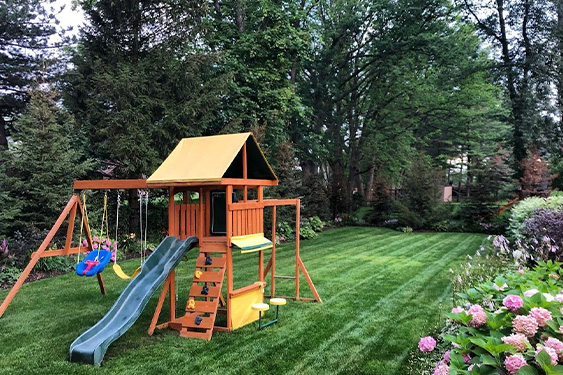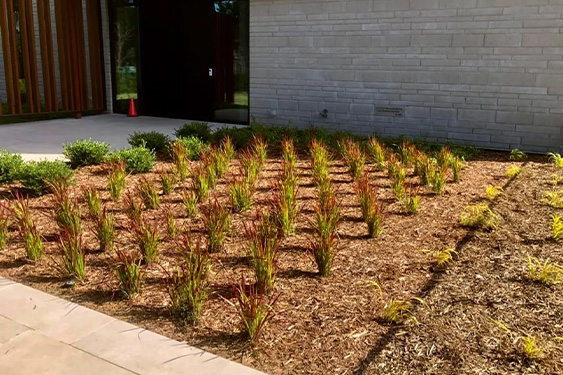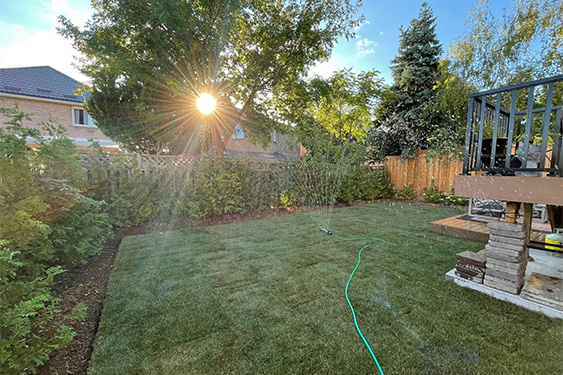Transform Your Outdoor Space with Integrating Hardscapes Designs
Integrating hardscapes into your landscape design can transform an ordinary outdoor area into a stunning and surprising functional space. Even if it´s only a small area. Hardscaping involves using non-living elements like stone, brick, concrete and wood to create beautiful and durable structures such as patios, walkways, retaining walls and water features. These elements not only elevate the aesthetic appeal of your space but also offer practical benefits like improved drainage, reduced maintenance and increased property value.
As a business owner here in Ontario, we have seen firsthand how effective hardscaping can be. Whether you’re a homeowner looking to enhance your backyard, a DIY enthusiast eager for a new project, or a landscaper seeking inspiration. Hardscaping offers endless possibilities. It allows you to create distinct outdoor areas for dining, relaxation and entertainment, seamlessly blending with our Canadian landscapes and architecture.
In this comprehensive guide, we will explore the benefits, planning steps and popular features of hardscape design, providing you with practical tips and creative ideas to bring your vision to life. From choosing the right materials and understanding the basics of design principles to implementing sustainable practices and incorporating lighting for ambiance, we aim to equip you with the knowledge needed to create an outdoor space that is both functional and beautiful.
Understanding Hardscapes
What Are Hardscapes?
Hardscapes refer to the non-living elements of landscape design. Unlike plants and greenery, hardscapes include structures such as patios, walkways, walls, and water features. These elements add structure and functionality to outdoor spaces, providing a foundation for your landscape design.
Examples of hardscape elements include stone pathways, concrete patios, wooden decks, retaining walls, fire pits, and garden sculptures. By incorporating hardscapes into your landscape, you can create defined areas for relaxation, entertainment, and visual appeal.
The Role of Hardscapes in Landscape Design
Hardscapes play a crucial role in enhancing the overall aesthetics and functionality of your outdoor space. They provide structure and organization, guiding movement and creating focal points that draw the eye. Hardscapes include elements such as patios, walkways, retaining walls and pergolas, all of which contribute to the layout and usability of the landscape.
In addition to their visual appeal, hardscapes can solve practical problems such as soil erosion, drainage issues and uneven terrain. Incorporating retaining walls can prevent erosion on sloped areas, while well-placed pathways can improve drainage and reduce muddy areas. By carefully selecting and integrating hardscape elements, you can achieve a harmonious balance between natural and man-made features.
Hardscapes also can enhance the functionality of your outdoor space by creating areas for entertaining, relaxing or even gardening. A thoughtfully designed patio can serve as an outdoor living room, while strategically placed walkways can lead guests through different sections of your garden, making the space more inviting and accessible. The integration of hardscapes in landscape design not only improves the visual appeal but also increases the usability and value of your property.
Benefits of Integrating Hardscapes
Aesthetic Enhancement
One of the primary benefits of hardscaping is its ability to enhance the visual appeal of your landscape. Hardscape elements add texture, contrast, and architectural interest, transforming a plain outdoor area into a visually stunning space. Whether you prefer a sleek and modern design or a rustic and natural look, hardscapes offer endless possibilities for customization.
Functionality and Usability
Hardscapes not only beautify your outdoor space but also improve its functionality. Patios and decks provide areas for outdoor dining and entertaining, while pathways and walkways create easy access to different parts of your yard. Retaining walls can level uneven terrain, creating usable spaces for gardening or seating. By integrating hardscapes, you can make your outdoor area more practical and enjoyable.
Increased Property Value
Investing in hardscape design can significantly boost the value of your property. According to the National Association of Realtors, a well-designed outdoor space with features like patios, fire pits, and water features can increase property value by up to 15%1. For a home valued at $500,000, this could mean an additional $75,000. Yeah I know, this is an american link / source. However, finding an official Canadian statistic on this topic is quite challenging.
A beautifully landscaped yard with thoughtfully integrated hardscapes not only enhances curb appeal but also creates lasting impressions on potential buyers. These elements provide functional outdoor living spaces while adding aesthetic value to your property. High-quality materials and professional installation ensure durability and low maintenance, which are highly appealing to discerning homebuyers who seek both style and practicality.
Whether you plan to sell soon or in the distant future, investing in hardscape design is a wise decision that pays off in multiple ways. By creating a stunning and functional outdoor space, you set your property apart from others on the market and attract buyers willing to pay a premium for such features.
Planning Your Hardscape Design
Assessing Your Space
Before starting your hardscape project, it’s essential to assess your outdoor space. Consider the size, shape, and topography of your yard. Identify any existing features, such as trees, slopes, or drainage areas, that may impact your design. Take measurements and create a scaled drawing to visualize how different hardscape elements will fit into your space.
Considering Climate and Environment
Climate and environmental factors play a crucial role in hardscape design. Consider the climate in your region and choose materials that can withstand local weather conditions. For example, in areas with freezing temperatures, opt for frost-resistant materials to prevent damage. Additionally, consider the impact of sun exposure and shade on your hardscape elements. Some materials may fade or become hot to the touch under direct sunlight.
Budgeting and Planning
Set a budget for your hardscape project and prioritize your spending based on your needs and preferences. Research the costs of materials, labor, and any additional features you want to include. It’s essential to plan your project in phases if necessary, starting with the most critical elements and gradually adding more features over time. Proper budgeting and planning will help you stay on track and avoid unexpected expenses.
Popular Hardscape Features
Patios and Decks
Patios and decks are among the most popular hardscape features, transforming backyards into functional outdoor retreats. They create versatile outdoor living spaces for dining, lounging, and entertaining, making them perfect for family gatherings or quiet relaxation. When designing a patio or deck, consider the size and layout that will best suit your needs, ensuring that there is enough space for furniture and movement. Additionally, think about the flow between indoor and outdoor areas for seamless integration. Choose materials such as concrete, pavers, or wood that not only complement your home’s style but also provide durability and low maintenance. Incorporate elements like lighting, planters, and seating to enhance the ambiance and usability of the space.
Walkways and Pathways
Walkways and pathways guide movement through your landscape and connect different areas of your yard. They can be made from various materials, including stone, gravel, or brick, each offering a unique look and feel. Stone pathways exude a natural charm, while brick pathways bring a classic, timeless appeal. Gravel, on the other hand, is both cost-effective and versatile. Consider the design and layout of your walkways, ensuring they are wide enough for comfortable passage and complement the overall aesthetic of your landscape. Additionally, think about incorporating gentle curves or interesting patterns to add visual interest and make your pathways more inviting. Proper edging and maintenance will also help keep your walkways looking their best throughout the seasons.
Retaining Walls
Retaining walls are functional and decorative elements used to manage slopes and create level areas in your yard. These structures help prevent soil erosion and can transform uneven terrain into usable, aesthetically pleasing spaces. They can be constructed from various materials such as stone, concrete, or timber, each offering its own unique look and benefits.
Stone retaining walls provide a natural and timeless appearance, while concrete walls offer strength and durability. Timber walls are versatile and blend well with garden landscapes. Retaining walls not only add visual interest but also provide opportunities for terraced gardens, seating areas, or raised flower beds. They can be customized to match your landscaping style and meet specific needs, creating a harmonious and practical outdoor environment.
Water Features
Water features, such as fountains, ponds, and waterfalls, add a sense of tranquility and elegance to your landscape. They create focal points and attract wildlife, enhancing the overall ambiance of your outdoor space. The soothing sound of water can also provide a calming effect, making your garden a perfect retreat from the hustle and bustle of daily life.
When incorporating water features, consider the maintenance requirements and ensure proper installation to prevent leaks and water damage. It’s important to choose the right type of water feature for your space, taking into account the size and layout of your garden. Additionally, think about the types of plants and fish that can thrive in and around your water feature to create a thriving ecosystem. Regular upkeep, such as cleaning filters and checking water levels, will keep your water feature looking beautiful and functioning efficiently.
Hardscaping Materials
Natural Stone
Natural stone is a popular choice for hardscaping due to its timeless beauty and durability. It comes in various types, including flagstone, slate, limestone, and granite. Natural stone can be used for patios, walkways, walls, and decorative elements. Each type of stone has unique characteristics, so choose one that suits your design preferences and climate conditions.
Concrete
Concrete is a versatile and cost-effective material for hardscaping. It can be molded into various shapes and textures, allowing for creative design options. Concrete is commonly used for patios, driveways, and retaining walls. Stamped and colored concrete provide additional aesthetic possibilities, mimicking the appearance of natural stone or brick.
Wood
Wood adds warmth and a natural feel to hardscape designs. It is commonly used for decks, pergolas, and fences. When using wood for hardscaping, choose rot-resistant varieties such as cedar or redwood and apply protective coatings to extend their lifespan. Regular maintenance, such as sealing and staining, is essential to preserve the beauty and integrity of wood elements.
Hardscaping for Different Spaces
Small Spaces
Hardscaping can maximize the potential of small outdoor spaces. In compact yards, focus on creating functional areas that serve multiple purposes. Consider vertical elements such as trellises or wall-mounted planters to add greenery without taking up valuable ground space. Choose smaller-scale hardscape features, such as a cozy patio or a compact water feature, to create a sense of intimacy and coziness.
Large Spaces
In larger yards, hardscaping can define different zones and create a sense of structure. Use pathways and walkways to guide movement and connect various areas. Incorporate expansive patios or decks for outdoor entertaining and relaxation. Consider adding large-scale features such as fire pits, outdoor kitchens, or pergolas to create focal points and enhance the overall functionality of the space.
Front Yards vs. Backyards
Front yards often serve as the first impression of your home. Hardscaping in the front yard can enhance curb appeal and create a welcoming entryway. Consider elements such as pathways, retaining walls, and decorative features to add visual interest. In backyards, hardscaping focuses on creating private and functional spaces for outdoor living. Patios, decks, and seating areas are popular choices for relaxing and entertaining.
DIY vs. Professional Hardscaping
DIY Hardscaping
DIY hardscaping projects can be rewarding and cost-effective, but they require careful planning and execution. Assess your skills and knowledge before taking on a project. Start with smaller, manageable tasks such as building a garden pathway or installing a simple patio. Research and gather the necessary tools and materials, and follow step-by-step guides and tutorials for guidance. Keep in mind that certain projects, such as large-scale retaining walls or complex water features, may require professional assistance.
Professional Hardscaping
Hiring a professional hardscape contractor offers several advantages. Professionals have the expertise, experience, and equipment to handle complex projects efficiently and effectively. They can provide valuable insights and recommendations based on their knowledge of design principles and local regulations. While professional services may incur higher costs, the quality and longevity of the finished product often justify the investment.
Cost Considerations
When deciding between DIY and professional hardscaping, consider the costs involved. DIY projects can save money on labor, but you must factor in the cost of materials, tools, and your time. Professional services may have higher upfront costs but can save you time and ensure a high-quality result. Obtain multiple quotes from contractors and compare them to your budget and project requirements.
Maintenance and Longevity of Hardscapes
Regular Cleaning and Inspection
To maintain the beauty and functionality of your hardscapes, regular cleaning and inspection are essential. Remove debris, leaves, and dirt from surfaces to prevent staining and damage. Inspect for cracks, loose stones, or shifting elements, and address any issues promptly. Regular maintenance will extend the lifespan of your hardscapes and keep them looking their best.
Seasonal Care
Different hardscape materials require specific seasonal care. For example, concrete and stone surfaces may need sealing to protect against freeze-thaw cycles. Wooden decks and structures should be cleaned, sealed, and stained to prevent weathering and rot. Regularly check for signs of wear and tear and perform necessary repairs or maintenance tasks to ensure the longevity of your hardscapes.
Preserving Hardscape Beauty
To preserve the beauty of your hardscapes, consider applying protective coatings or sealants. These treatments can enhance the appearance of natural stone, concrete, or wood while providing a barrier against moisture, UV rays, and stains. Follow manufacturer recommendations for application and reapplication intervals to maintain the protective benefits.
Professional Installation Services
Benefits of Professional Installation
Investing in professional hardscape installation services can yield significant benefits. Professionals have the expertise to design and execute complex projects, ensuring high-quality results. They can provide valuable insights and recommendations, helping you make informed decisions about materials, design elements, and layout. Professional installation also saves you time and effort, allowing you to enjoy your beautifully landscaped outdoor space sooner.
Oakly Landscaping Services
When it comes to professional hardscape installation, Oakly Landscaping offers comprehensive services for both residential and commercial properties. Their team of skilled professionals specializes in creating stunning hardscape designs that enhance the beauty and functionality of outdoor spaces. Whether you’re looking to transform your backyard or upgrade your commercial property, Oakly Landscaping has the expertise and resources to bring your vision to life.
For more information on Oakly Landscaping’s services, visit their Commercial Landscape Installation and Residential Landscape Installation pages.



